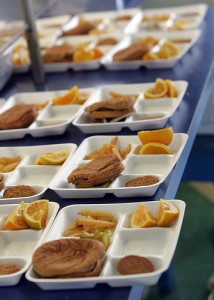 Some schools in the region have been in session for a month now. It has been interesting to hear the feedback about the new school cafeteria guidelines that went into effect this year.
Some schools in the region have been in session for a month now. It has been interesting to hear the feedback about the new school cafeteria guidelines that went into effect this year.The United States Department of Agriculture oversees the National School Lunch Program. The objective of the program is to, “To provide a nutritious, well-balanced lunch for children in order to promote sound eating habits, to foster good health and academic achievement and to reinforce the nutrition education taught in the classroom. A school lunch will provide 1/3 of the Recommended Dietary Allowances for lunch and be consistent with the Dietary Guidelines for Americans and caloric goals.”
New meal pattern requirements indicate every school meal must include fruit, vegetables, grains, meat or meat alternative and fluid milk.
Sounds like a win, right? Well, not exactly.
If you read the lunch program fact sheet found online at http://www.fns.usda.gov/cnd/lunch, you will see there are calorie limits per each age group. The age groups are broken up into Kindergarten through fifth grade, sixth through eighth and ninth through twelfth.
The first age group is what is most concerning to parents as they know a fifth grade boy will eat more than a kindergarten age girl. The potential to under or over nourish a child in that age bracket is high.
North Dakota’s Agriculture Commissioner Doug Goehring is calling for revisions in the school meal program.
“The guidelines are currently based on a “one-size-fits-all” formula without consideration of individual needs, especially those of physically active and growing students,” Goehring says. “The guidelines deprive these students of sufficient calories and protein for healthy growth and mental alertness.”
He also questions the restrictions on meat protein something Beatrice, Neb. senior Travis Eubanks is also concerned with. The high schooler, who is less than enthusiastic about what has been showing up on his school plate has started the blog schoollunchessuck.blogspot.com. On it he provides the public a weekly visual of what he consumes at lunchtime.
After viewing the blog I had to ask myself, Since when did pepperoni classify as a high quality meat protein?
It was encouraging to see black bean salsa and a sloppy joe on the same plate once in the blog, but the author quickly pointed out those were the only “meaty” items on the plate to help fill him up. The rest was tomato, lettuce, slice of pear and milk. And as a high school athlete he noted he was likely to be hungry in a few hours.
Which brings me to the next “beef” I have had parents mention to me about their school food programs – the availability of snacks. When I was in school we had one milk break a day. Yes, orange juice and maybe even chocolate milk were an option, but that was it. We did not have a snack machine to purchase extra food out of during school hours.
It is understood that the home environment of today’s children is much different than past generations. Breakfast at home, after school snacks made by a parent and family suppers are not as commonplace today.
Which means nutritional education for our students might be even more important than we thought. And putting the right foods and snacks options in front of them is necessary.
Ag Commissione Goehring is introduced a resolution at the National Association of State Departments of Agriculture meeting in Des Moines, Iowa, urging the U.S. Department of Agriculture to reassess and revise the new dietary guidelines implemented through the National School Lunch and Breakfast program.
“I believe my counterparts from other states will be supportive,” says Goehring. “This issue has raised concern in other states besides North Dakota.” Goehring sauys he believes the new guidelines are well-intentioned, but fall short of providing a comprehensive policy for educating students in healthy living. He also said the health care profession should be part of the dialogue because of its knowledge of child growth and development.
“Overly restrictive guidelines in the school lunch program will not solve the serious, national problem of childhood obesity,” says Goehring. “What is needed is a more comprehensive approach, including dietary education and increased physical activity, to help students adopt a healthier lifestyle.”
Farm to School Program
There is another option to help get the foods you would like offered to your children into their school lunch program. The Farm to School Network is designed to help school districts either establish their own gardens or connect with local growers to bring in fresh produce for use in school meals.
Schools that have established farm to school programs say the benefits are huge. While fresh produce is a main perk, the program has also helped sustain local agriculture and given school children a better understanding of where their food comes from.
Each state has a Farm to School Network representative. Listed on the national website, www.farmtoschool.org. For our region are:
Colorado
Jim Dyer
970-588-2292
jadyer@frontier.net
Iowa
Tammy Stotts
515-281-7657
Tammy.Stotts@IowaAgriculture.gov
Kansas
Barb Depew
785-456-7388
bdepew@ksde.org
Minnesota
JoAnne Berkenkamp
Institute for Agriculture and Trade Policy
612-870-3410
jberkenkamp@iatp.org
Montana
Aubree Durfey
Farm to School Consultant, Gallatin Valley Farm to School
aubree@gvfarmtoschool.org
406-581-8209
North Dakota
Sue Balcom
701-486-3569
sbalcom@farrms.org
South Dakota
Holly Tilton Byrne
605-697-5204
hollyt@dakotarural.org
Wyoming
Cindy Garretson-Weibel
307-777-6589
cindy.weibel@wybusiness.org
– Codi Vallery-Mills
